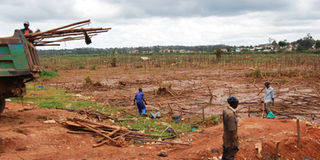Prime
Experts warn of water scarcity as wetland encroachment escalates

DESTRUCTION: Some residents invaded the Lubigi Wetland and put up market stalls there.
Kampala
For the last 15 years, Uganda has lost about 4,000 square kilometres of wetlands to degradation, posing a risk of water shortage, experts from Water and Environment Ministry have said.
From 13 per cent coverage of wetlands, the area has dropped to 11 per cent coverage within the same period, experts from the Wetlands Department in the ministry reveal. Urban areas and developing towns are the most prone to degradation due to exploding population and unregulated activities on wetlands.
The Commissioner for Wetlands, Mr Paul Mafabi, said the situation will get worse if urban planners do not strategise for the increasing population. “We may have an exploding population but if it is not well planned for then people will resort to wetlands as a means of settlement and survival,” he warned.
Floods
Mr Mafabi and his team have been carrying out a study on the state of wetlands in the country with preliminary results revealing that major wetlands and their biodiversity are dying out with a serious potential water stress and flooding in the next 10-15 years should wetlands be depleted. Wetlands play a major role in withholding water and releasing it in small amounts.
Mr Mafabi also warned that important bird species such as the Crested Crane, Uganda’s national symbol, whose only habitat is seasonal swamps, would soon get extinct, if their breeding haven are destroyed. The most common forms of wetland degradation include, Murum filling, poor cultivation, industrial pollution and digging channels. Districts where wetlands are under serious degradation are Kampala, Mbale, Jinja, Wakiso, and Pallisa.
While wetlands in northern Uganda are still intact, Mr Mafabi says parts of swamps in Lira are already under attack, saying urban settlers seem to be finding their way into the wetlands. “Gulu has not been so much of a problem but lately as the town is expanding we are beginning to see some effects around Pece, and some areas around the town,” Dr Mafabi said.
The western region is also seeing fresh encroachment in Buweju which has affected water supply in Bushenyi District. In Mbarara, the Rwizi system has continued to diminish due to degradation.
Dr William Muhaire of the National Water and Sewerage Corporation said encroachment on River Rwizi has greatly reduced the amount of water produced in the district with residents sometimes harvesting only mud from the river.
Wetlands are vegetated land areas that are flooded either permanently or seasonally. In Uganda, their most common vegetation is papyrus, but, other wetlands include bogs, flood plains and swamp forests.
In addition to the unplanned exploding population, Dr Mafabi says poor agriculture practices that deplete nutrition of highlands have put the lowland wetlands under attack. But this is also met with an elusive government policy on wetlands to permit ‘developers’ on the wetland, eventually destroying it. “If the population is properly planned for and areas of agriculture correctly utilised then we shouldn’t see the problem of encroachment due to rural urban migration, unplanned settlement is big problem,” said Mr Mafabi.
However, the Commissioner for Physical Planning at the Ministry of Lands, Mr Vincent Byandaimire, says plans are in place to protect the wetlands but the actual implementation is sometimes difficult as directives may come from different angles and planners over the same wetland or land. “Many times the planners from local government may not sit on the same table to give a similar directive and this incoherence results in one party giving out the wetland,” Dr Byandamire said.
Environment analysts say the problem could be potentially solved if the Physical Planning Act which will start working in month time is implemented. Dr Byandaimire said the Act will give an avenue for all planners to sit and lease land jointly. The country also has several laws in place to protect wetlands from degradation.
The National Environment Act Cap 153, The National Environment (Wetland, River banks and lakeshore management) regulations 2000 and the Constitution, prohibit reclaiming, erecting or removing structures, drilling or disturbing, depositing substances likely to have effects on the wetland, destroying part of it or introducing any exotic plant or animal in the wetland.
The penalty for wetland degradation is a fine of not less than three months in prison or a fine not less than Shs30,000 and not more than Shs3 million. However, wetland protectors often times intervene when degradation has already occurred.
For instance, the approval of an Environment Protection Force has not been effected while a draft Regulations Law for wetlands is being formulated and could ensure wetland protection and incorporate penalties and a protection unit.
With Uganda’s population estimated to reach 60 million by 2030, analysts say it remains the task of the 9th Parliament to pass the upcoming laws which could see wetlands rest from encroachment but that should also be coupled with implementation.




